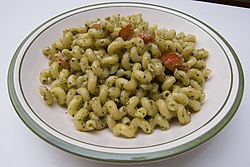Cavatappi
 Cavatappi served with pesto sauce | |
| Alternative names | Cellentani, serpentini, trivelle, stortelli, spirali, double elbows, amori |
|---|---|
| Type | Pasta |
| Place of origin | Italy |

Cavatappi [kavaˈtappi] is macaroni formed in a helical tube shape. It is the Italian word for corkscrew. It is known by other names, including cellentani, amori, spirali, tortiglioni, or fusilli rigati. It is usually scored with lines or ridges (rigati in Italian) on the surface. Cavatappi is a type of macaroni, or thick, hollow pasta that is made without using eggs. It sometimes has grooves or ridges, known as rigati, on the outer surface. It may be yellow in color, like most pastas, or have a food coloring added to make it green or red. It can be used in a variety of dishes to include salads, soups, and casseroles.
Etymology
Cavatappi is an Italian word created by compounding "cava tappi", which literally means "tap extractor" (a corkscrew). It is known by many other names. Some of these include amori, serpentini, trivelle, stortelli, cellantani, or spirali.[citation needed]
Shape
The cavatappi shape is perhaps best described as a ridged tube extruded into a helix shape though a small number of rotations. The number of turns is commonly in the range of 1–3[citation needed] (with fewer than one full turn, the shape degenerates into a twisted version of elbow macaroni).
While the word "spiral" is often used colloquially to describe helical objects (such as a spiral staircase), in mathematics a spiral is considered to be a curve on the plane of progressive radius, and the name "helix" is preferred for a curve inscribed on a cylinder, such as that of DNA's double helix. The notion of a screw as a helical surface dates back to the time of Archimedes.[relevant?]
Common recipes
Cavatappi is used with Italian-style foods such as Cavatappi Amatriciana,[1] pesto Americana, and cavatappi pomodoro.[2] It is mostly found in tomato based pasta and is associated closely with different types of cheeses such as mozzarella, parmesan, and provolone.[citation needed]
See also
References
- ^ "Carrabbas Cavatappi Amatriciana Side Dish Pasta) Recipe - Food.com". www.food.com. Retrieved 2016-02-08.
- ^ "Cavatappi Pomodoro". Just A Pinch Recipes. Retrieved 2016-02-08.
External links
